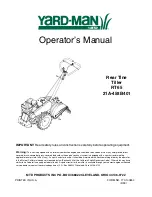
JOHNSON CONTROLS
67
SECTION 5 – MAINTENANCE
FORM 160.81-NOM1
ISSUE DATE: 10/3/2020
5
The refrigerant charge level must be checked after the
pressure and temperature have equalized between the
condenser and evaporator. This would be expected
to be 4 hours or more after the compressor and water
pumps are stopped. The level should be at the center of
the upper sight glass.
Charge the refrigerant in accordance with the method
shown under “Refrigerant Charging.” The refrigerant
level should be observed and the level recorded after
initial charging.
HANDLING REFRIGERANT FOR DISMANTLING
AND REPAIRS
If it becomes necessary to open any part of the refriger-
ant system for repairs, it will be necessary to remove
the charge before opening any part of the unit.
Condenser –
In a condenser, trouble due to fouled
tubes is usually indicated by a steady rise in head pres-
sure, over a period of time, accompanied by a steady
rise in condensing temperature, and noisy operation.
These symptoms may also be due to foul gas buildup.
Purging will remove the foul gas revealing the effect
of fouling.
Tube Fouling
Fouling of the tubes can be due to deposits of two types
as follows:
1.
Rust or sludge –
which finds its way into the
tubes and accumulates there. This material usu-
ally does not build up on the inner tube surfaces
as scale, but does interfere with the heat transfer.
Rust or sludge can generally be removed from the
tubes by a thorough brushing process.
2.
Scale –
due to mineral deposits. These deposits,
even though very thin and scarcely detectable
upon physical inspection, are highly resistant to
heat transfer. They can be removed most effec
-
tively by circulating an acid solution through the
tubes.
TUBE CLEANING PROCEDURES
Brush Cleaning of Tubes
If the tube consists of dirt and sludge, it can usually be
removed by means of the brushing process. Drain the
water sides of the circuit to be cleaned (cooling wa-
ter or chilled water), remove the heads and thorough-
ly clean each tube with a soft bristle bronze or nylon
brush. DO NOT USE A STEEL BRISTLE BRUSH. A
steel brush may damage the tubes.
Improved results can be obtained by admitting water
into the tube during the cleaning process. This can be
done by mounting the brush on a suitable length of
1/8" pipe with a few small holes at the brush end and
connecting the other end by means of a hose to the wa-
ter supply.
The tubes should always be brush cleaned before acid
cleaning.
Acid Cleaning of Tubes – If the tubes are fouled with
a hard scale deposit, they may require acid cleaning.
It is important that before acid cleaning, the tubes be
cleaned by the brushing process described above. If the
relatively loose foreign material is removed before the
acid cleaning, the acid solution will have less material
to dissolve and flush from the tubes with the result that
a more satisfactory cleaning job will be accomplished
with a probable saving of time.
COMMERCIAL ACID CLEANING
In many major cities, commercial organizations now
offer a specialized service of acid cleaning evaporators
and condensers. If acid cleaning is required, Johnson
Controls recommends the use of this type of organiza-
tion. The Dow Industries Service Division of the Dow
Chemical Company, Tulsa, Oklahoma, with branches
in principal cities is one of the most reliable of these
companies.
TESTING FOR EVAPORATOR AND
CONDENSER TUBE LEAKS
Evaporator and condenser tube leaks in R-134a systems
may result in refrigerant leaking into the water circuit,
or water leaking into the shell depending on the pressure
levels. If refrigerant is leaking into the water, it can be
detected at the liquid head vents after a period of shut-
down. If water is leaking into the refrigerant, frequent
purging will be necessary and system capacity and effi-
ciency will drop off sharply. If a tube is leaking and wa-
ter has entered the system, the evaporator and condenser
should be valved off from the rest of the water circuit
and drained immediately to prevent severe rusting and
corrosion. If a tube leak is indicated, the exact location
of the leak may be determined as follows:
1. Allow the system to warm up until a substantial
pressure is reached for testing. Dry nitrogen (pres-
sure not to exceed 12 PSIG (83kPa)) may be ad-
mitted to the unit to increase pressure in the shell.
Remove the heads and listen at each section of
tubes for a hissing sound that would indicate gas
leakage. This will assist in locating the section of










































